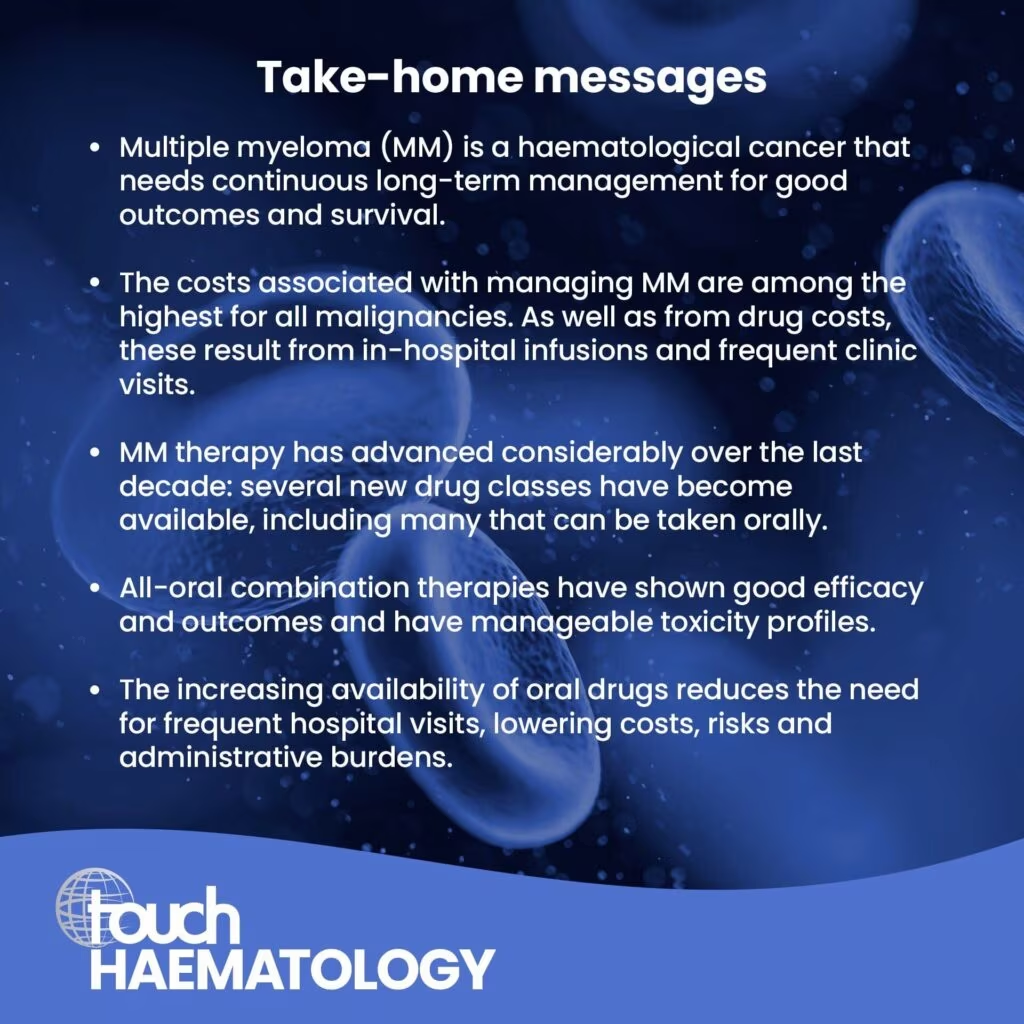Multiple myeloma (MM) is a haematological cancer needing continuous, long-term management. Treatment is lifelong and involves numerous clinic visits to receive intravenous or parenteral drugs, and this is burdensome not just for patients but for providers, too. Indeed, the costs associated with treating and managing the condition are among the highest of all malignancies.
MM therapy has advanced considerably over the last decade and several new drug classes have become available, including many that can be taken orally. Moving from parenteral or intravenous therapies to oral drugs could revolutionize MM treatment: improving convenience, streamlining management and reducing the costs and risks of frequent clinic visits.
In a new review published in touchREVIEWS in Oncology & Haematology, Sachi Singhal, MD, an internist at the Department of Internal Medicine at Crozer–Chester Medical Center, Pennsylvania, and Shaji Kumar, MD, a consultant in the Division of Hematology at the Mayo Clinic, Minnesota, have comprehensively reviewed the oral therapies for MM. They summarize clinical considerations including dosing, monitoring and side effects for the key drug classes. Then, they distil key efficacy and safety data from over 30 clinical trials, presenting this in a series of informative tables.
“For myeloma, drugs are given in combinations, either in pairs, doublets or triplets based on risk stratification, genetics, disease stage, transplant eligibility and progression of disease”
Oral therapies for MM include immunomodulatory drugs, proteasome inhibitors, histone deacetylase inhibitors, and newer drugs including selinexor and venetoclax. As with any drugs, individual agents have differing characteristics and as such are used in different clinical scenarios. These key considerations are discussed in turn.
Immunomodulatory drugs include thalidomide, lenalidomide and pomalidomide. Thalidomide is used in newly diagnosed and relapsed disease, while lenalidomide is typically a maintenance treatment after stem cell transplant. Pomalidomide is more potent than the others and is used in relapsed/refractory disease. All are teratogenic, so patients receiving them need regular pregnancy tests.
Of the proteasome inhibitors, ixazomib was the first oral agent to reach clinical trials. It was approved in 2015 in combination with lenalidomide and dexamethasone for relapsed/refractory MM: the first all-oral combination to include a proteasome inhibitor and an immunomodulatory drug. Its convenient once-weekly dosing and manageable toxicity means ixazomib is under investigation for further MM indications: for maintenance following stem cell transplant, and as a single or part of a combination therapy for relapsed/refractory and newly diagnosed MM.
Until recently, the histone deacetylase inhibitor panobistat was approved in combination with bortezomib (another proteasome inhibitor) and dexamethasone for relapsed MM; however, it was recently withdrawn amid concerns that more research is needed on its efficacy in this setting.
Selinexor is a new drug that came to market in 2021 in combination with dexamethasone for heavily pre-treated relapsed/refractory MM. Selinexor selectively inhibits nuclear transport and is effective even in patients whose MM is refractory to at least two proteasome inhibitors, at least two immunomodulatory drugs and an anti-CD38 antibody.
Venetoclax is a B-cell lymphoma (BCL)2 inhibitor: inhibiting this pro-survival protein restores the apoptotic ability of malignant cells. Although not yet approved for MM, it has shown efficacy in other haematological cancers and in refractory MM; particularly those with the t(11;14) translocation that can increase BCL2 expression.
Melphalan – an alkylating chemotherapeutic agent – plus prednisone is a well-studied oral regimen that was for over 40 years the standard of care for newly diagnosed MM. Its use, along with that of cyclophosphamide has declined due to its toxicity and the advent of more effective regimens, but it is still used for palliation and for conditioning before autologous stem cell transplantation.
Patients on these therapies need monitoring for toxicity. Most agents mentioned cause cytopaenias, so regular complete blood counts are needed. Many cause gastrointestinal effects, and others have immunological or dermatological side effects. Nevertheless, by reducing the unnecessary clinic visits associated with giving in-hospital infusions, the authors suggest that “healthcare providers, as well as caregivers, may benefit from a reduced administrative burden.”
This reduced administrative burden with oral regimens does not come at the cost of reduced efficacy compared with parenteral or intravenous regimens. In their comprehensive review of key clinical trials, the authors explain that “many all-oral combinations significantly improve outcomes and survival compared with conventional therapies.” Objective response rates for triplet regimens for newly diagnosed MM range from 57–84%, with progression-free survival more than a year; even in patients with relapsed/refractory disease some all-oral regimens can elicit objective response rates of up to 90%, and 36-month overall survival rates of nearly 85%.
The authors conclude that “shifting towards an all-oral regimen will reduce financial burden, mitigate a large proportion of time spent travelling and in hospital, and prevent excess exposure of these immunocompromised individuals to nosocomial organisms.” They end with the suggestion that “a thorough discussion and focus on patient preference, comorbidities, availability of a caregiver, functional status and ability to report adverse effects is imperative in choosing the final line of therapy, and this decision must be individualized for each patient.”

Read the full article by Sachi Singhal and Shaji Kumar on touchONCOLOGY:
Oral Therapies for Multiple Myeloma
touchREVIEWS in Oncology & Haematology. 2022;18(2):139-51 DOI: https://doi.org/10.17925/OHR.2022.18.2.139

